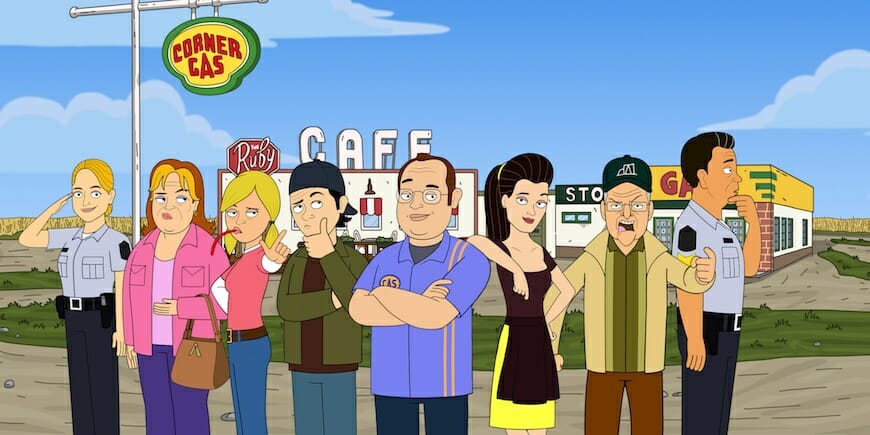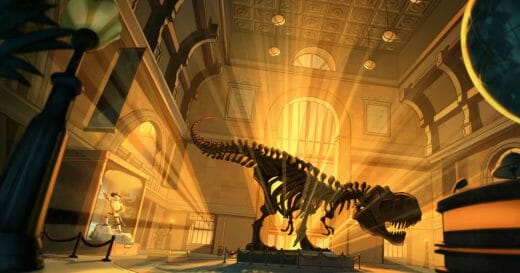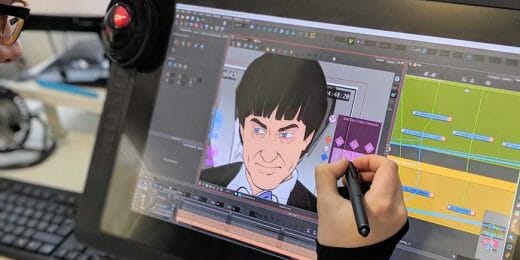
According to Corner Gas creator Brent Butt, there isn’t a singular Canadian sense of humour. Having been a stand-up comedian in the country for 30 years and served as showrunner on one of its most successful sitcoms for six seasons, he is an expert. Plus, he makes a good point: Rick Mercer is nothing like Russell Peters, The Kids in the Hall is vastly different from This Hour Has 22 Minutes. While there may not be a monolithic definition of Canadian humour, it seems many in the Great White North agree Corner Gas Animated is hilarious.
Butt will be opening up about the hit adult animated comedy during his keynote address and panel discussion at the Ottawa International Animation Festival on September 27. He will be sharing about how the series came to be and its production processes, and be joined by studio animators to answer more technical questions. Fans will get a look into Corner Gas Animated’s pipeline, including the fact that it is entirely animated in Canada (i.e. no foreign outsourcing), with preproduction done in Toon Boom Storyboard Pro.
As its title would imply, Corner Gas Animated is the cartoon successor to the original series. Butt returns as creator, executive producer, showrunner and star, and is joined by most of his live-action cast mates (Corrine Koslo plays Emma Leroy after Janet Wright’s passing in 2016). Corner Gas Animated’s first episode, “Bone Dry”, became Comedy Channel’s most-watched premiere ever, with over 360,000 viewers when it launched in April 2018.
By the time season one wrapped in June, Corner Gas Animated had become the Comedy Channel’s most-watched original series. A second season began preproduction in Toon Boom Storyboard Pro in July and is set to hit Canadian airwaves in 2019. It’s no surprise the show is such a success: it unites Butt’s lifelong passions of comedy, storytelling and animation.

Source: Comedy Central.
As the youngest of seven children growing up in rural Saskatchewan, Butt used humour to bridge the intellectual and emotional gap between him and his older siblings. He came by his skills honestly; his family would sit around the dinner table telling stories and trying to make each other laugh. After graduating high school, he went on to pursue a short-lived education in animation.
“I was accepted to Sheridan College to study animation, went there and four days later I quit — I never went to a single class,” Butt says with a laugh.
While he loved animation and drawing, stand-up comedy was his true path. So Butt got his mother’s tuition money back, moved home and did odd jobs like graphic design and advertising sales. He briefly relocated to Saskatoon to develop a comic book with a friend before heading to Toronto to pursue his stand-up career — and hasn’t looked back since. Yet the whole time, he was always drawing and sketching.
This affinity for illustration made animation an obvious choice when network executives asked him if he was interested in continuing the Corner Gas television series after the 2014 feature film became a sold-out hit. Butt wasn’t sure live-action felt right — particularly given the cast was aging and Janet Wright was in poor health at the time.
“You know when they went back to Gilligan’s Island and Gilligan had white hair? It felt weird and wasn’t right somehow. I always felt protective of Corner Gas and its legacy — I didn’t want to do something that would screw it up. Because of my background, I said, ‘Why don’t we try animating?’” says Butt.
Vancouver-based animator Josh Mepham worked with Butt on the character design. Then, a three-minute demo was made. Former Corner Gas and King of the Hill screenwriter Norm Hiscock advised Butt not to change a thing about the formula. He said the dialogue-driven humour would translate perfectly and to just keep writing scripts.

Source: Smiley Guy Studios.
The key element that changed between the live-action series and Corner Gas Animated was the fantasy sequences — cutaway gags that got turbo-charged in the new show. In a sequence of “Bone Dry”, Brent’s gas station is situated in the middle of a desert and surrounded by a Mad Max-style convoy led by his elderly father. These over-the-top scenarios are where animation truly shines as a storytelling and comedic medium.
While Butt may have an animation background, he believes in hiring others and allowing their talents to shine. He writes the scripts and sends them off to season two co-directors Stephen Evans and Mateusz Garbulinski of Smiley Guy Studios. Unless he has a specific vision in mind, he lets their imaginations run wild.
“When I started doing the live-action Corner Gas, one of my favourite things was seeing how the director would start blocking scenes based on his or her vision of my script. It was almost always so different from how I saw it in my head and I always loved that,” says Butt.

Source: Smiley Guy Studios.
“It’s the same in the animated world with the storyboards. The first time I get that animatic, see how they drew it and framed it and any camera movements, I’m always tickled,” he continues.
The preproduction team will export files from Storyboard Pro for Butt to review and do revisions on. Evans oversees this portion of production. He learned Storyboard Pro three years ago while working on Netflix’s F is for Family in Los Angeles and has been a Toon Boom advocate ever since.
“I had previously storyboarded in Flash, which is not ideal and kind of clumsy. The transition from Flash to Toon Boom was really easy; the drawing quality in Storyboard Pro alone won me over — if only vector drawing could be this smooth all the time!” Evans says.
Because Butt wants to stay close to the live-action series, it is often used as a reference for storyboards and backgrounds. Additionally, Evans is encouraging his board artists to use Storyboard Pro’s library functions make preproduction faster and smoother.
“Storyboard timelines are so compressed now that any amount of reuse can make our jobs more efficient. [Storyboard Pro] helps use meet those crazy deadlines and stay on-time,” says Evans.

Source: Smiley Guy Studios.
He continues, “The drawing tools are such a pleasure to work with; Storyboard Pro allows you to draw fast and sketchy during the thumbnail stage. You can draw and think like an editor, storyboard artist and actor at the same time. You move panels and hit beats, and it enables us to get a real feel for the rhythm of the show right off the bat — you certainly couldn’t do that if you were storyboarding in Photoshop or Flash.”
As Butt, Evans and the rest of the Corner Gas Animated team get through preproduction on season two in Toon Boom Storyboard Pro, they find more and more that the series has found its unique rhythm. They are also getting more experimental with the comedic cartoon’s content and animation.
“Sometimes, we come up with strange ideas in the writing room that we can’t do — and sometimes we can try them. Next season, we’re briefly incorporating a couple of actor’s live faces into the animated world and it creeps everybody out,” says Butt.
Given the positive reaction to season one, fans can hardly wait. And while a unified Canadian sense of humour may not exist, Corner Gas Animated certainly gets the country laughing together.
Those who can’t make it to Brent Butt’s keynote address at the Ottawa International Animation Festival should check out his YouTube channel “The Buttpod”.



